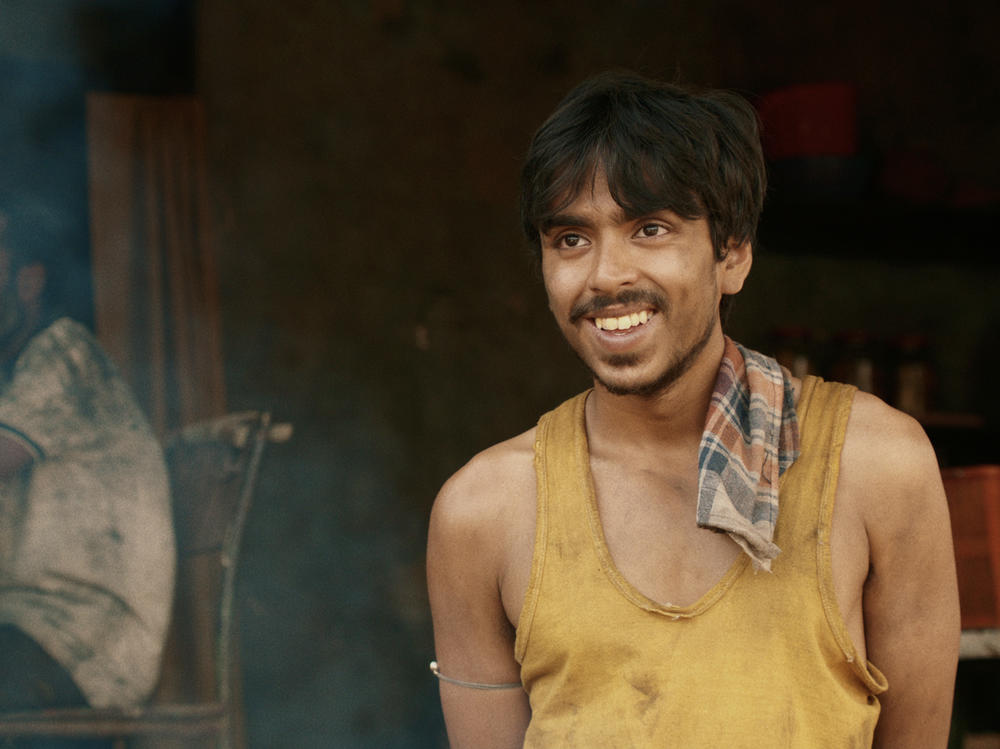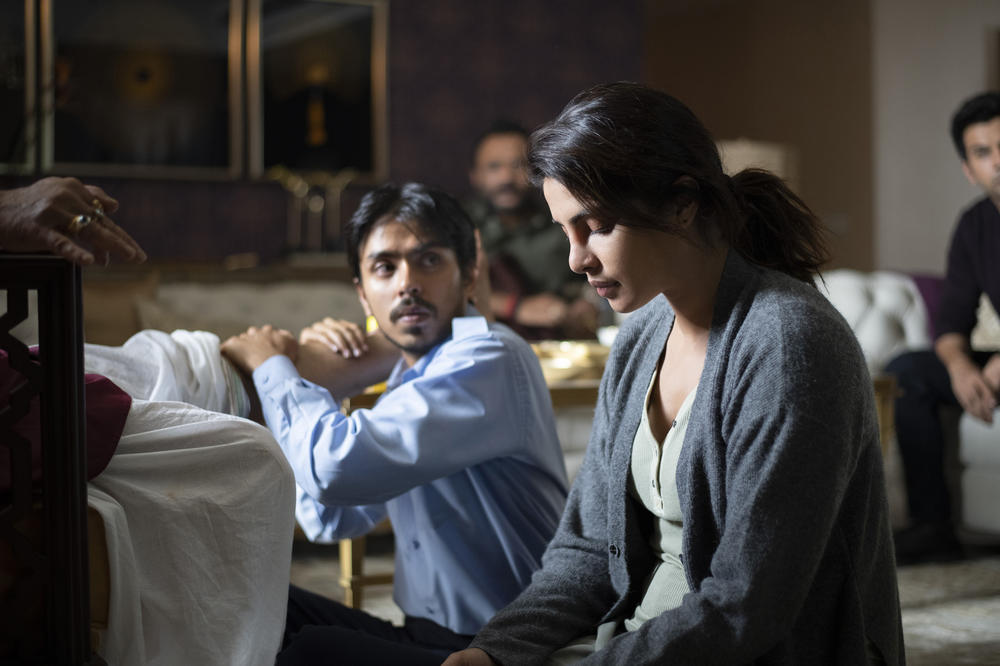Section Branding
Header Content
What Indians Who've Known Poverty Think Of Netflix's 'The White Tiger' Movie
Primary Content
"Do we loathe our masters behind a façade of love, or do we love them behind a façade of loathing?"
This is just one of the questions that Balram Halwai, a poor, village-bred Indian boy and the central character of the movie The White Tiger, asks himself as he works as a chauffeur to a rich businessman in Delhi.
The movie, newly released on Netflix, is an adaptation of the Booker Prize- winning debut novel of the same name by Indian author Aravind Adiga. Produced by Priyanka Chopra Jonas and directed by Ramin Bahrani, the film offers a grim tale of corruption and betrayal, examining the complex dynamics of the employer-servant relationships in India while delving into the country's stark rich-poor divide and its class and caste issues.
A predominant image in the movie is the rooster coop — a metaphor for the oppression of India's poor:
"The greatest thing to come out of this country ... is the Rooster Coop. The roosters in the coop smell the blood from above. They see the organs of their brothers ... They know they're next. Yet they do not rebel. They do not try to get out of the coop. The very same thing is done with human beings in this country."
Here's what people who've experienced poverty in India have to say, starting with that rooster coop image. Warning: There are spoilers ahead if you've not yet watched the film or read the book.
Mohammed Wajihuddin says he is ok with the rooster coop comparison. "Having been born into a poor but large family, I could relate a lot with the film's story," says Wajihuddin, senior assistant editor at The Times of India in Mumbai. "The poor have few choices to make about their careers. They mostly swim with the tide."
Even if you can beat the odds, your own family's expectations can be unrealistic and weigh on you heavily. Wajihuddin explains how his father, a schoolteacher, had expected him to take up a career in medicine or become a bureaucrat even though he wasn't interested in those jobs. "In the movie, Balram's grandmother is very harsh with him when he fails to send back money to his family, since there were many mouths to feed. It reminded me of how my own father was unhappy when I could send him only Rs 10,000 [$137] for my sister's wedding. I had saved this money from my meager salary while starting out as a journalist two decades ago. I could relate to Balram's anxiety at not being able to do much for his family back home."
Not everyone feels the rooster coop image was an apt representation. Vaishali Shadangule, 42, founder of the fashion house Vaishali.S, left her hometown of Vidisha, about 500 miles from Mumbai, as a 17-year-old, with only the clothes on her back and the burning need to escape the limitations of a small town. Traveling ticketless on the train out of her hometown and headed for the northern Indian city of Bhopal, she had no money and no plan either.
"I disliked the way the movie portrays poor people," she says. "I thought it catered to the white Western gaze, reinforcing stereotypes that the poor are helpless."
The overriding theme of the rooster coop in the movie is offensive and insulting, she says, because it dehumanizes poor people and implies that anyone born poor is subservient and servile. "India is a country with the harshest social divides," says Shadangule. "But I disagree when Balram says that the only way the poor can enrich themselves is if they follow a life of crime or politics. He feels no remorse even when he kills his employer, because it enables him to transcend the cycle of poverty — I think that's a dangerous message and one that detracts from the years of untiring effort, discipline and the sheer passion that many poor people use to rise above the circumstances."
But she identifies with Balram's struggle. In the early days in the city, she remembers, every social interaction left her feeling painfully out of place and awkward.
"Living in a small town, you lack a certain exposure, which makes you feel alien in the city," she says. In this respect, she identifies with Balram's struggle. She wanted to make it big as a fashion designer but had to do many odd jobs at first when she arrived in Bhopal and later moved to Mumbai, working as an office assistant and gym instructor to make ends meet. She eventually started her own retail store, but it took her ten years of hard work before she could save money to study fashion formally. She put herself through college, funding a postgraduate course in fashion in Milan from her earnings.
"I started with nothing, and yet, I don't remember being resentful of anyone," she says. "Eventually, I think my small-town roots helped me focus on the people involved in the fashion industry who are often not seen or heard. It helped me value people more."
In the movie too, Balram uses his intelligence to break free of his own small-town shackles. As a child, he shows academic promise. He is the only student fluent in English and who can think outside the box, prompting a teacher to call him a "white tiger" — a rare beast in the jungle. He wins a scholarship to study in Delhi. Yet, his dream of getting a proper education is crushed after the death of his father, who is sick with tuberculosis and unable to seek treatment because the nearest health-care facility is two days away. The family cannot afford to pay for Balram's living expenses in Delhi, and he is forced to work in a tea shop. "I never saw the inside of a school again," he says.
The movie's portrayal of the cycle of intergenerational and systematic poverty is engrossing and haunting, says Abraham George, author of India Untouched: The Forgotten Face of Rural Poverty. He's also the founder of the George Foundation (now Shanti Bhavan), a nonprofit that has educated over 400 underprivileged children in the last 23 years, roughly half of them from rural villages.
While education is often the key to raising yourself from poverty and verbal abuse, (such as the kind that Balram suffered from his employer's family), that's not true for everyone, he says. Even with a good education, poor women in particular have difficulty finding well-paying positions that wield authority and are often hindered by the bias against hiring women in general.
The movie also comments on the caste system in India, an ancient and rigid code of social division typically based on the occupations that people once performed. "Dalits [an umbrella term for people belonging to the lowest castes in India, called "untouchables"] face even greater hurdles," says George.
We are constantly told that Balram is a "Halwai" — belonging to a lower caste who are traditionally makers of sweets. But Balram believes that money can help him transcend and obliterate anything.
"In the old days there were one thousand castes and destinies in India. These days, there are just two castes: Men with Big Bellies, and Men with Small Bellies. And only two destinies: eat — or get eaten up," he says.
However, in real life, being able to rise above poverty doesn't necessarily end caste discrimination. This is a false narrative peddled by the movie, says Benson Neethipudi, a graduate student at Columbia University. Neethipudi grew up in the southern Indian city of Visakhapatnam. He is a policy professional and an advocate for equality and justice — especially in relation to caste.
An education, a good job, financial status — all this may help people considered lower caste to shield themselves from prejudice and physical violence, but the discrimination doesn't stop just because they happen to strike it rich, he says.
When Neethipudi's father wanted to buy an apartment in an upscale housing society in his city, the property owners politely told him "unfortunately, we do not sell homes to people from your community." They were referring to his status as a Dalit.
"Because my father was an engineer and had a respectable job, the casteism was polite," says Neethipudi. "But if a family member back in our native village ever tried to engage with dominant caste landlords in such equal terms or attempted to demand equal access to opportunities and resources, consequences could range from loss of employment as farm labor, social ostracization, or even physical violence. And that is the delicate reality of caste even in 21st century India."
Yet the film still hammers home a powerful message, says journalist Mohammed Wajihuddin: "Even the poor have a right to dream big and to realize that dream."
Copyright 2021 NPR. To see more, visit https://www.npr.org.


